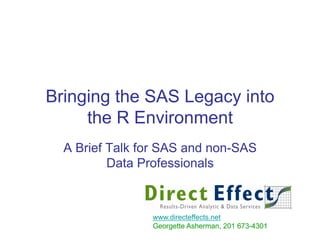
Bringing the SAS Legacy into the R Environment: A Brief Introduction
- 1. Bringing the SAS Legacy into the R Environment A Brief Talk for SAS and non-SAS Data Professionals www.directeffects.net Georgette Asherman, 201 673-4301
- 2. What is SAS? • The company – SAS, Inc. positions itself now as ‘the leader in business analytics software and services, and the largest independent vendor in the business intelligence market.’ Broad range of enterprise products. – Sales in 2008 2.26 bil. Up from 1.13 bil. in 2001 – 120 countries, 45,000 customer organizations, 92 of the Fortune 100 have a product of theirs. • The core product-SAS® 9.2-An integrated language and analytics package that supports various add-ons in a common environment
- 3. The Legacy Jim Goodnight, a statistician at North Carolina State, wrote the ‘Statistical Analysis System.’ He and three others started The SAS Institute as a company in 1976. The company remains privately-held and is known for its full-service employee- friendly campus. They remained in core product but incorporated current technology as it becomes mainstream. This year they introduced an interface with R with their IML®/Studio Product.
- 4. Data Structures SAS Dataset R Data Frame Obs. No. Subject City Score Row Subject City Score Label 1 1 2 2 3 3 4 4 5 5 6 6 7 7 8 8
- 5. Comparison of R Data frame and SAS Dataset SAS Dataset R Data Frame 1. Each named column 1. Each column contains one contains one type of data. type of data. Really a list of Really a stack of rows named vectors 2. No row names but 2. Row names-default to row observation numbers, _N_ numbers and retained 3. Subsetting via statements 3. Subsetting via [rows, cols] such as IF, WHERE, KEEP 4. Extensive functions for DROP reading in flat files and other 4. INFILE statement and INPUT proprietary data formats statements work for flat files. PROC IMPORT reads in EXCEL files.
- 6. The SAS Computing Structure Macro Language and Macro Variables Data Step Procedures (PROCs)
- 7. A SAS Session in Windows
- 9. Why people love SAS proc contents data load(file = “filesfromSAS.RData”) =sashelp.shoes; shoes$netsales<-shoes$sales-shoes$returns run; set.seed(23) data work.shoes; set sashelp.shoes; shoes$var.for.random<- runif(nrow(shoes)) netsales=sales-returns; #need Hmisc package to add variable var_for_random=ranuni(23); labels label str(shoes) netsales="Sales Adjusted for #Hmisc also has something more like Returns" PROC CONTENTS var_for_random="Random Number from Uniform Distribution"; format netsales dollar8.0; run; Language not case sensitive!
- 10. Why people hate SAS data sim1; set.seed(23) do i=1 to 100; var.for.random<-runif(100) var_for_random=ranuni(23); #Can do anything with the vector now-rename, add to a list, bind to output; a dataset, etc. end; drop i; run; *Data set with 1 variable and 100 rows.
- 11. The SAS Concept of Output In Version 8.0, SAS introduced the Output Delivery System (ODS). This new language structure freed users from the default text-based list output. It allows the following: • Send output to RTF, EXCEL, HTML and PDF formats. • Modify output with template language. • Modify default output and access requested output as SAS datasets. • Retained OUTPUT statement for older procedures but new procedures now use ODS statements to make data sets for statistics, residuals and other analysis files. • New ODS Graphics in Version 9.2.
- 12. Descriptive Statistics *default output from PROC summary(shoes) PROC MEANS data=work.shoes; #default output-use other functions to RUN; get different statistics *default output from PROC-can use output.for.shoes<-summary(shoes) statements to change ; #output with class ‘table’. Similar to list. Counts for factors and PROC MEANS data=work.shoes noprint; percentiles for numeric variables OUTPUT out=work.meansdata; RUN; *send to an OUTPUT data set; PROC PRINT data =meansdata;
- 13. Class Level Processing • There is a BY Statement that • by function similar to SAS BY requires data grouped by statement but does accepts a data classification level or pre-sorted. frame in any ordering. Results in • There is a more flexible CLASS output of class table Statement by.output<-by(shoes[c("Sales")], shoes[c ("Region","Product")],mean) proc means data =shoes mean noprint; • aggregate results in data frame and var sales; tapply in matrix output out=classdata ag.output<-aggregate(shoes$Sales,by=shoes[c mean=mean ; ("Region","Product")],mean) class region product; run; tapply.output<-tapply(shoes$Sales,shoes[c ("Region","Product")],mean) Need to write new function in order to get all the levels into one data object. proc print data=classdata noobs; run;
- 14. Simple Linear Regression • Different PROCs available for • lm function – Limited default regression depending on you output so assign to a list object focus-output a little different from with class “lm” each attach(shoes) lmexample<-lm(Returns~Sales Proc GLM; +Inventory) Model Returns=Sales Inventory; summary(lmexample) Run; Proc REG; • Summary function for lm gives Model Returns=sales inventory; nearly the same output as PROC REG. Run; Different PROCs such as GENMOD for non-normal errors such as logistic regression
- 15. Recommended Books R For SAS and SPSS Users, Robert A. Muenchen, Springer Science & Business Media: New York, 2009 Applied Statistics and the SAS Programming Language, 5th ed. Ronald P. Cody and Jeffrey Smith, Prentice Hall: New York, 2005 The Little SAS Book: A Primer, 4th ed.Lora Delwich and Susan Slaughter, SAS Institute: Cary 2008 Documentation and support available on SAS Website www.support.sas.com SAS and IML are registered trademarks of SAS, Inc. See txt and rtf files for output discussed in this talk.